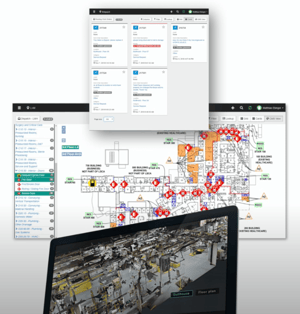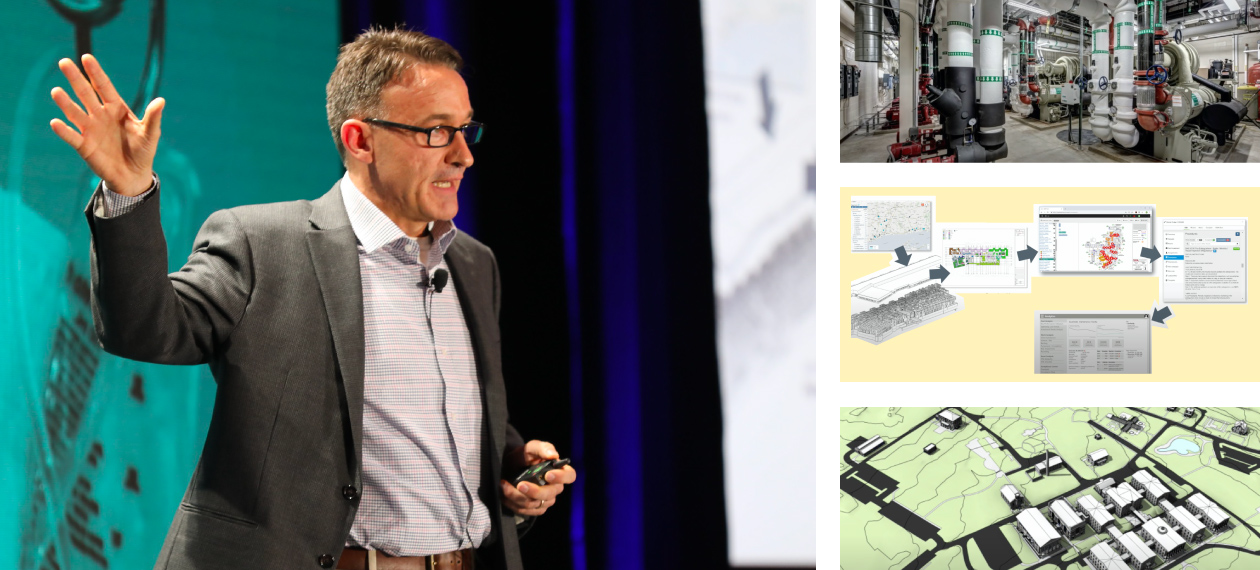Data is not in short supply in Facilities Management. Increasingly, Facilities Managers have access to vast troughs of data. Yet, getting value from this data has been elusive, mostly due to a lack of standardization that would make the data sets correlate.
Still, the future of healthcare facilities relies on this data.
Ensuring a streamlined future for healthcare facilities through Digital Transformation was the topic of a talk at HealthSpaces by Matthias Ebinger and Mo Haidar, both senior directors of digital solutions at Enstoa.
"As we think about Digital Transformation for the built environment, we have to think about organizing data," Haidar said. "There's a lot of cool technology out there. The potential is great, but to get value from all these tools requires quite a bit of work."
Enstoa is assisting leading healthcare organizations in getting to this value. Enstoa identifies data strategies and standards, such as developing practical taxonomies for building systems, assets, and spaces, and roadmaps to get to a point where data becomes valuable.
It's not a simple task: both Ebinger and Haidar highlight that it takes strategy, time, and coordination to make digital transformation successful within a healthcare organization.
A Clear Strategy
"The most important part is to have a clear strategy," Ebinger said of structuring the digital transformation. "It is important to know what you want to get out of the system, what analytics you want to drive, and what business processes will support your analysis."
A good strategy contains a big picture overview and a roadmap that incrementally builds structures and capabilities within an organization. As software gets implemented or renewed, each incremental investment should align with the big picture and move the organization closer to a digitally competent state.
One organization Enstoa worked with took the approach to start with a simple inventory of their overall real estate interests. "This allows them to generate a repository of information for each of their locations," Ebinger said. "The organization established placeholders for all the data that they wanted to collect, so that they were clear as to exactly what data needed to be collected once they started the process."
A Patchwork of Data
Few organizations, however, start from scratch. More often than not, data exists in numerous applications, sometimes even duplicated across these existing systems.
One client had infrastructure equipment labeled with six different barcodes. Each sticker represented an attempt by the organization to solve a tactical problem of their asset management challenge, but never managed to set up a strategic, comprehensive, and integrated approach. Ebinger notes that weak data suffocates facilities with such patchworks of data. Working in a poor-data quality environment is frustrating since personnel is stuck with data that is challenging to improve substantially.
Solving the data problem in such a context through "incrementalism," as Ebinger called it, is a difficult proposition to start, and often layers yet another attempt on top of all the previous ones. These organizations must press the reset button, develop a strategic approach to data strategy, and then tackle the set up of useful data comprehensively.
Silver Bullets
Many solutions to fix broken data environments in facility management have been proposed in the past. Some were positioned to be a cure-all for data disorganization, such as the use of BIM in Operations & Maintenance. "BIM came with an enormous promise," Ebinger said. "Often, the BIM group within a design and construction team would schedule presentations with facilities operators, walk them through their BIM model and suggest that the model would solve all of the operational data problems," he added.
Few understand that facilities operators don't need the detail-rich data of a design and fabrication BIM model. "Not only because they didn't have the staff to maintain these models, but more importantly, because they needed data on existing facilities in a more lean format. A one-line diagram is incredibly effective in showing how a building system works," Ebinger said. "It is tough to get that level of clarity and simplicity from a Revit model."
Best-practice organizations have their facilities operations teams develop data standards on how they need to see building data. Typical use cases include the inspection, testing, and maintenance of building assets, the tracing of systems to manage shutdowns, the optimization of space use, or the documentation and management of the building's life safety features. These use cases don't need a complex geometrical 3D data, but instead, data tailored to those use cases.
Taking Ownership
In order to generate meaningful facilities data and data strategy, it is critical to give the facilities operations teams a lead voice. They know what data is important to maintain a facility over many years. "A good strategy document starts with the end in mind," Ebinger said. Facilities leaders must involve the building operators when developing the organization's FM data strategy.

|
Once the data needs for facilities operators are defined, they are bundled into data handover guides for design and construction teams. A good data standard provides architects, engineers, and contractors (AECs) with a concise guideline on what data the organization wants at the end of a project. Otherwise, it has a hands-off approach to how the AECs should handle their data during the project.
Successful facilities leaders pay close attention to getting these data standards fully aligned with the overall data strategy since they become the recipe on how FM data is generated.
"Facilities owners maintain a concise and lean set of master building data, and then drive the standards of this data set through the lifecycle of a building," Ebinger said. "At the beginning of a project, we need to introduce the designer and contractor to the existing master data set to use as their starting point, so they appreciate the type of data needed at the end of the project. While we don't want to interfere with how they run their construction project, we do want to be very specific as to what that data set needs to look like at the end of the project, so that we can ingest it and merge it back into our master building dataset."
Adapting to Software
Another aspect of successful digital transformation is the realization that successful organizations adjust to their software rather than having their software adjust to them. "We have always felt that we run our business a certain way, and that software has to adjust to us. That is changing," Ebinger said.
Smart organizations realize that good software comes as a bundle of "hardcoded" best practice. Aligning business practices with the software is, in almost all cases, a worthwhile endeavor. "If you do process improvements for capital construction or maintenance operations and have a good software package, you get a lot more value out of it if you are willing to adjust to it, rather than forcing the software to support your sometimes idiosyncratic processes," he said.
Getting Value
Creating a robust digital strategy, and navigating through the transformation journey doesn't come free. "Good data requires an initial investment and the long-term support of a team that can keep the data in a good state," Ebinger said. A good example is "Lean BIM": The price for laser scanning has dropped so far that more and more organizations are developing architectural models using reality capture and generating precise 3D models. These models can then produce the operationally needed 2D drawings for space management and life safety and also serve as a strong starting point for all construction projects.
Investing in the scanning process and the set-up of a Lean BIM model is a modest initial investment. However, it allows an organization to then maintain their Master Building Data with a lean in-house team on a sustained basis. "It's a game-changer," Ebinger said. "That was not possible before. With this, you can re-baseline and set up a clean starting point."
Creating A Standard
The healthcare industry is already very structured, with federal and state requirements dictating many aspects of how to manage facilities. "Everyone knows that data is the solution. But having each organization figure it out for itself is a burden for the overall health care FM industry," Ebinger said. “It can take a month or two to just negotiate the naming of equipment and assets when working with organizations.”
Enstoa has been supporting a national effort to drive standardization across the healthcare industry. "We found a lot of interest across the industry in developing standards for facilities management," Ebinger said. Enstoa is working with partners to create common nomenclatures for the naming of facilities systems, assets, and spaces, aligning them with Uniformat, NFPA, TJC, and the FGI, to just name a few of the frameworks that they currently considered for the new standard.
While there's still much work to be done on embracing digital transformation and creating a meaningful dataset, the healthcare industry is well on its way.
----------------
For Enstoa's full recap of HealthSpaces and more on digital transformation in healthcare, click here.

Posted by
Collaborate with your Peers!
HealthSpaces is a community for people that plan, design, build and operate spaces where healthcare is delivered.
June 7-9, 2026 | Braselton, GA
Learn More




-4.png)
-Dec-09-2025-05-48-44-4379-PM.png)
-4.png)
-1.png)
-2.png)

Comments